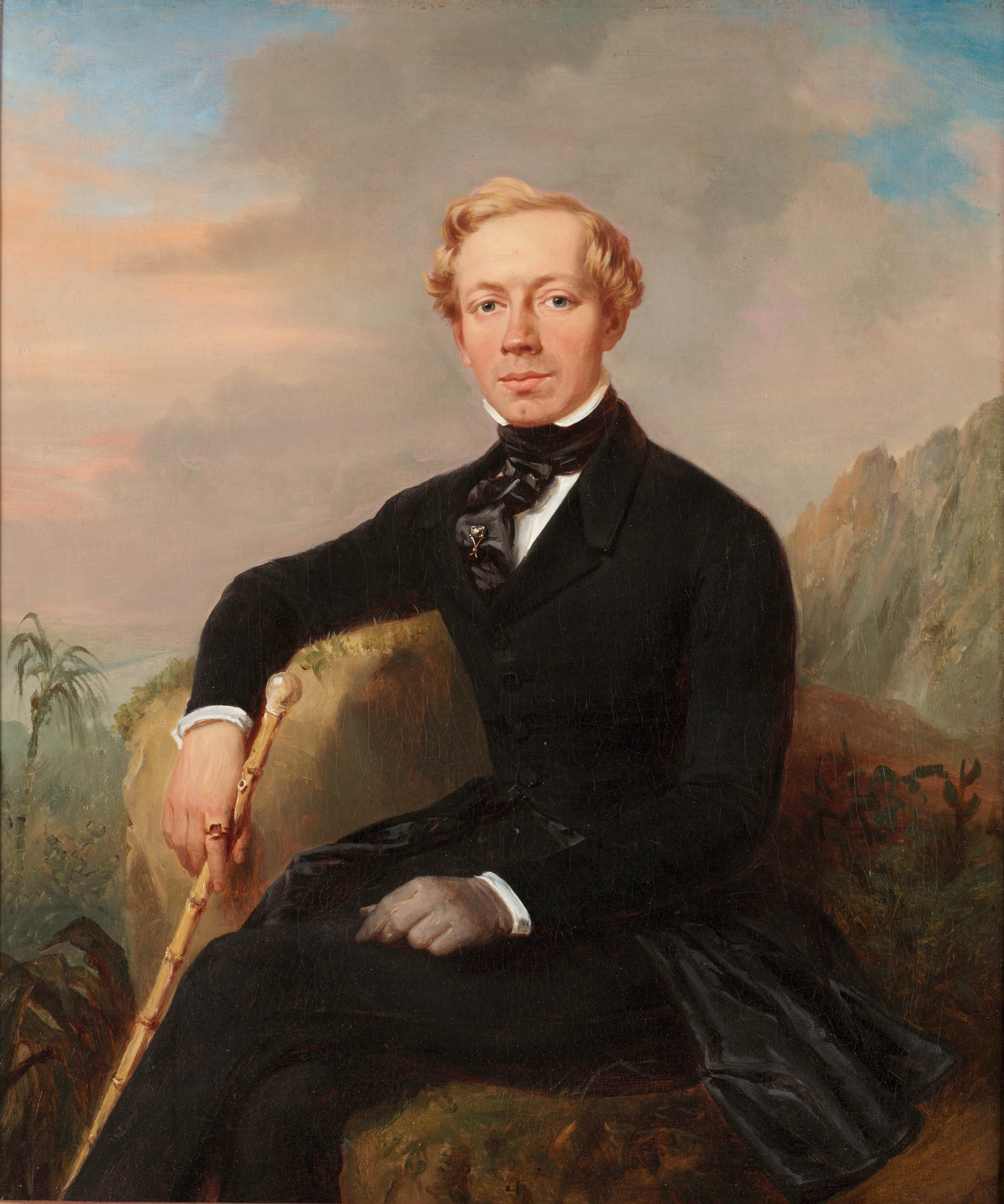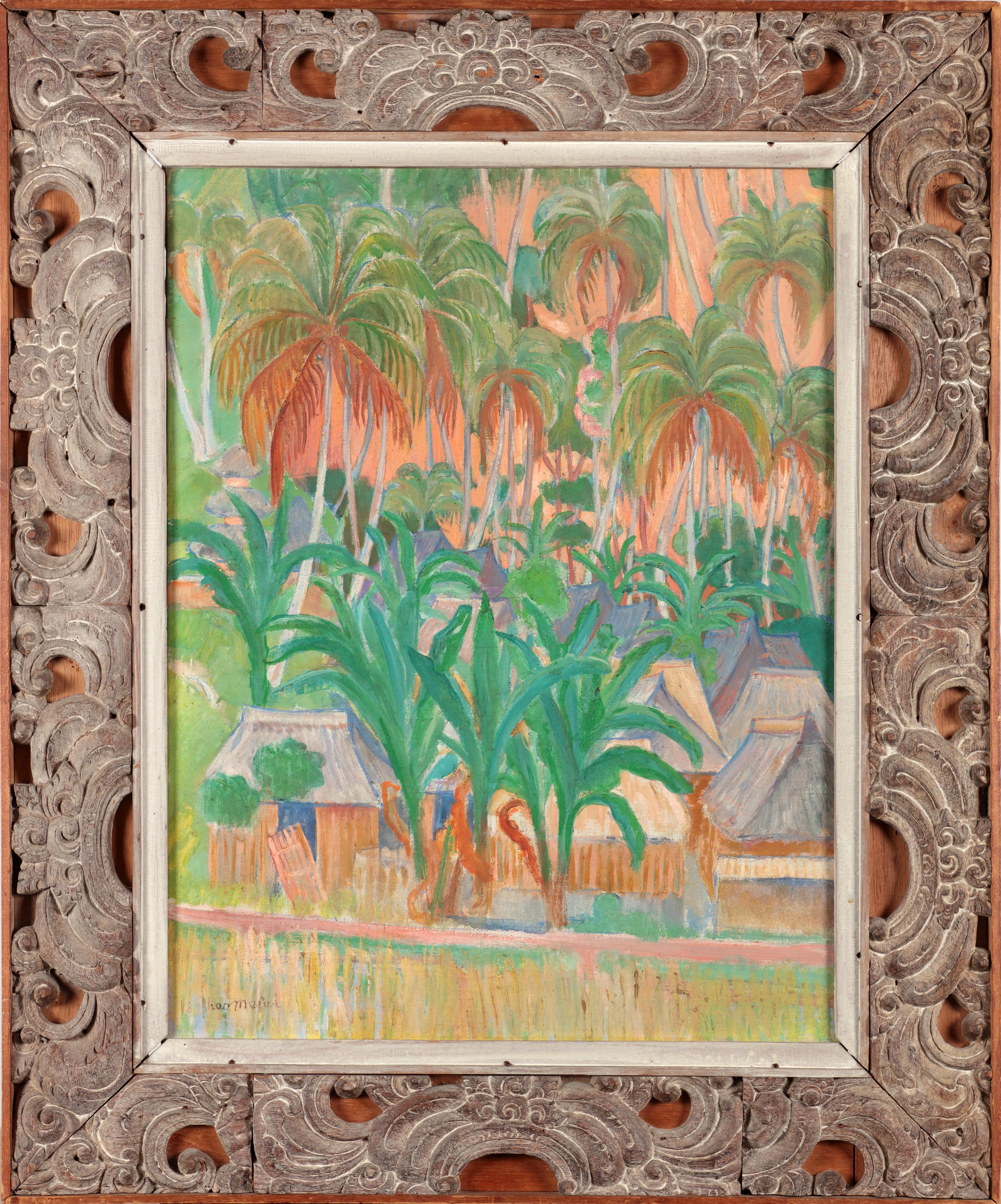Items Similar to Ligurian pine forest
Video Loading
Want more images or videos?
Request additional images or videos from the seller
1 of 18
Henry Markò (Firenze 1855-1921)Ligurian pine forest
About the Item
Henry Markò (Florence 1855-1921)
Ligurian pine forest
Oil on canvas in gilded frame
First quarter 20th century
Signed to the lower left
Size: 74x104 cm (92x121 cm including frame)
Henry Markò, born in Florence, is a landscape and seascape painter of remarkable sensitivity, undoubtedly linked to the late 19th-century painting tradition with hints of Romanticism.
A descendant of the painting dynasty headed by the Austrian Andrea Markò, he painted a series of works between the nineteenth and twentieth centuries that were characterized by skillful scenic layout: rare seascapes of the Ligurian Riviera, luminous and highly detailed in execution, numerous wooded landscapes, sometimes enlivened by figurines, and frequent views of cities such as Florence, Rome, Genoa, and Sestri Levante, which demonstrate his constant work throughout the country, thus coming into contact with the most illustrious pictorial personalities of the time, including, as some publications report, the Ligurian painter Antonio Discovolo without, however, being influenced pictorially.
Much of his activity took place in Tuscany, especially in Florence, where, after all, Andrea Markò and Carlo Markò the younger, carried on a Landscape School that represented at that time the most advanced pictorial instances in the sphere of modern landscape painting, before the advent of the "revolutionary "Tuscan Macchiaioli movement.
In fact, the work of Andrew and his disciples was derived, in particular, from the Art of Calame and the Barbizon school.
Henry Markò in the final part of his artistic career, moved permanently to Liguria, in Lavagna, where he favored a landscape painting of local scope.
All works sold by us come with a certificate of authenticity and data sheet.
It is possible to view the works directly at the Como gallery, 50 Armando Diaz Street
Works are delivered personally or shipped to Italy and abroad with professional packaging, usually custom-made wooden crates. Shipments are covered by nail to nail insurance.
We remain at your disposal for any further information.
- Creator:Henry Markò (Firenze 1855-1921)
- Dimensions:Height: 36.23 in (92 cm)Width: 47.64 in (121 cm)Depth: 3.15 in (8 cm)
- Medium:
- Period:
- Condition:
- Gallery Location:Como, IT
- Reference Number:1stDibs: LU2536212494872
About the Seller
5.0
Vetted Seller
These experienced sellers undergo a comprehensive evaluation by our team of in-house experts.
Established in 1993
1stDibs seller since 2023
- ShippingRetrieving quote...Ships From: Como, Italy
- Return PolicyA return for this item may be initiated within 14 days of delivery.
More From This SellerView All
- Portrait of a MusketeerLocated in Como, ITTITO CONTI (Florence 1842 - 1924) Portrait of a Musketeer Oil on canvas in gilded frame Signed in the upper right Canvas measures 40x30 cm (51x43 cm includ...Category
19th Century Figurative Paintings
MaterialsCanvas, Oil
- Saint Francis of Assisi comforted by an angelLocated in Como, ITGuglielmo Caccia said the Moncalvo (Montabone, 1568 - Moncalvo, 1625) Saint Francis of Assisi comforted by an angel Oil on canvas, cm 96 x 73 - (wi...Category
Early 17th Century Old Masters Figurative Paintings
MaterialsCanvas, Oil
- Grazing HorseLocated in Como, ITRuggero Panerai (Firenze 1862-1923) Grazing horse Oil on canvas in gilded frame Canvas size 100x70 cm (116x86 cm with frame) Signed at the bottom left Last quarter 19th century Ruggero Panerai was born in Florence on 13 March 1862. He was employed as a carpenter until the age of fifteen and then studied at the Academy of Fine Arts in Florence, which he attended from 1877 to 1881. His teacher was Giovanni Fattori, who introduced him to the naturalistic painting of landscapes of the Tuscan Maremma and considered him among his most deserving students. Factors' teachings were decisive in orienting the young artist, who adopted the themes and the pictorial technique, updating them with the naturalism flowered in Tuscany through the example of Luigi and Francesco Gioli, Tommasi and Egisto Ferroni. In 1883 he exhibited at the Promotrice in Florence, his impressionism was inspired by the works of Guido Carocci. His painting is also affected by the bourgeois and worldly look of Giuseppe De Nittis and the manner of Vittorio Matteo Corcos who for some years lived in Paris but who returned to Livorno from time to time. Useful for a contact with the Parisian culture could also have been, for Panerai, the proximity with Francesco and Luigi Gioli, who in 1878 went to the French capital, where they had frequented Federico Zandomeneghi. Panerai was also attracted by the military theme. Military subjects are in fact among the most practiced and loved by the artist, who declines them in numerous variations, mostly devoid of pathos, but adhering to a quiet image. In 1887 his painting "Il Guado", presented in Venice, was chosen for the National Gallery of Modern and Contemporary Art in Rome, but instead entered the "Pisani" Gallery. In the same year he exhibited in Genoa, Florence and Milan, where he won the Fumagalli Prize with "Il cavallo malato" (Florence, Galleria d'arte moderna of Palazzo Pitti), a painting in which his qualities as a sensitive animalist painter stand...Category
19th Century Animal Paintings
MaterialsCanvas, Oil
- The Holy Family with Saint John the BaptistLocated in Como, ITCircle of Bernardo Castello (1557-1629) The Holy Family with Saint John the Baptist 1600-1615 circa Oil on canvas in gilded frame Measures in cm: 84 x 63 cm (104 x 84 cm including frame) Measures in inch: 33.07 x 24.80 in (40,95 x 33,08 in including the frame) One of the most widespread iconographies in Italian painting from the Renaissance onwards, that of the Holy Family, is set in a sober and at the same time elegant interior, as the presence of the gold-edged green curtain that closes the space like a backdrop states. Whether it takes place in the intimacy of the house in Nazareth, as in the painting presented here, or it is placed outdoors, the scene includes the presence in the role of protagonists of the Madonna and Child Jesus, flanked by the protective figure of Joseph, always held a slightly aloof. In some cases, including ours, the Child is in dialogue with the little John the Baptist, thus alluding to the role played by the latter in the history of salvation, as the gesture of Jesus explicitly indicates in our canvas, who blesses the one who will be destined to baptize him in the waters of the Jordan. The 'room' dimensions, the calm religious intonation that pervades the representation, underlined by the very evident presence of the haloes, attest that the painting was conceived for the private devotion of its client and probably intended for a bedroom or for the walls of a small home chapel. The cleaning carried out in recent times allows you to appreciate the bright and lively chromatic range, orchestrated on the refined harmony between the shades of the Virgin's robes - blue and carmine red - and the bright green of the curtain that forms the backdrop to the scene. A particularly delicate pictorial drafting, well appreciated in the soft rendering of the faces and limbs of the two children - observe, for example, the suffused chiaroscuro transitions of the face of Jesus - is combined with a sensitive and tender description of the 'affects', allowing us to place this painting in the context of the painting of the Catholic Counter-Reformation and of the principles of verisimilitude and naturalness advocated by it in reaction to the expressive licenses and formal abstractions of the Mannerist figurative culture derived from Michelangelo's lesson. The return to a sober and juxtaposed pictorial language and simplified compositional schemes, often inspired by the early sixteenth century examples of Raphael and Andrea del Sarto, which we also recognize in our Holy Family, characterizes the work of numerous artists scattered throughout the various centers of the Peninsula , from the Bologna of the Carracci, to the Tuscany of Santi di Tito, to the Marche of Federico Barocci, up to Rome, Naples and Milan, where Camillo Procaccini and Guglielmo Caccia...Category
Early 17th Century Figurative Paintings
MaterialsCanvas, Oil
- Portrait of a ButteroLocated in Como, ITTITO CONTI (Florence 1842 - 1924) Portrait of a Buttero Oil on canvas in gilded frame Signed in the upper right Canvas measures 40x30 cm (51x43 cm includin...Category
19th Century Figurative Paintings
MaterialsCanvas, Oil
- Ettore Cosomati (1871-1960) Still life of Marigolds with lemons and pipeLocated in Como, ITEttore Cosomati (Naples 1871 - Milan 1960) Still life of Marigolds with lemons and pipe Oil on canvas in gilded frame Size: 53 x 45 cm (73 x 64 cm including frame) Epoch: the paint...Category
Early 20th Century Still-life Paintings
MaterialsCanvas, Oil
You May Also Like
- Venice Landscape Italian Oil on Canvas Painting in Gilt Wood Frame, Belle EpoqueLocated in Firenze, ITThis delightful turn of the century (early 20th century) oil on canvas painting represents an Italian landscape with one of the most famous squares in the world: Piazza San Marco in ...Category
Early 20th Century Impressionist Landscape Paintings
MaterialsCanvas, Oil
- Houses And River-Large Impressionist Landscape Oil on Canvas Signed A.HuntingtonLocated in Coimbra, PT"Houses And River" Signed A. Huntington (English School) Oil on canvas Measures: Canvas - 60x110 cm (Gilt Wood Frame - 76x126 cm) Private collection. FramedCategory
Early 20th Century Impressionist Landscape Paintings
MaterialsCanvas, Oil
- J. Brunner 1869 Oil on Canvas Austrian Landscape with Lake and Mountain PaintingLocated in Firenze, ITThis very fine quality 19th century oil on canvas in dark brown wood frame with gold leaves details throughout is signed by Joseph Brunner (Vienna 1826-...Category
19th Century Romantic Landscape Paintings
MaterialsCanvas, Wood, Oil
- Self-portrait in Indonesian LandscapeLocated in Amsterdam, NLAbraham Johannes Romswinckel (1810-1856) Self-portrait in Indonesian landscape Inscribed Abr. Joh. Romswinckel, geb. Batavia 17 Oct. 1810, overl...Category
1820s Romantic Portrait Paintings
MaterialsCanvas, Oil
- A pair of Indonesian Landscapes, by Charles Legrain (19th century)Located in Amsterdam, NLCharles Legrain, (19th century) Two Javanese landscapes Both signed Legrain Ch. and one dated 1857 Both oil on canvas, size: 95 x 114 cm In rich gilt-gesso frame. (2x).Category
Mid-19th Century Romantic Landscape Paintings
MaterialsCanvas, Oil
- Evening prayers by fishermen under the high coast of CelebesLocated in Amsterdam, NLJacob Eduard Van Heemskerck Van Beest (1828-1894) “Avondgebed; Maleidische tripang visschers onder de hoge kust van Celebes” (Ev...Category
19th Century Romantic Landscape Paintings
MaterialsCanvas, Oil





